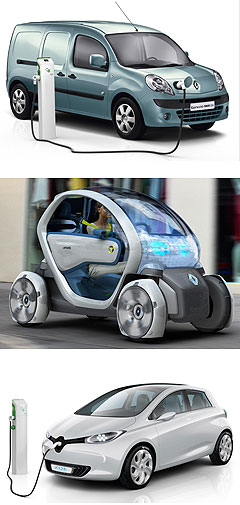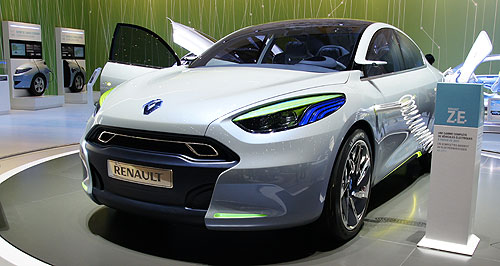News - Renault - Fluence - ZEOz says no to Renault EVs, yes to ClioUnlikely: Renault Australia cautions that its EV range is not likely to come to our shores any time soon. Renault’s revitalised Australian outpost sets sight not on EVs but the next Clio15 Apr 2011 AUSTRALIAN Renault fans should not hold their breath for the French manufacturer’s ground-breaking new range of all-electric vehicles but could have access to next year’s all-new Clio hatch range. Renault’s South Korean affiliate Samsung Motors confirmed at the recent Soul motor show that the Fluence ZE will enter full-scale production alongside conventionally powered versions of the small sedan at its Busan plant next year, potentially making Renault’s first mass-production EV significantly cheaper in Australia. However, Renault Australia managing director Justin Hocevar made it clear at this week’s launch of Renault’s all-new Latitude flagship that neither the zero-emissions Fluence or the Kangoo ZE commercial van – or the Twizy and Zoe EVs that the Renault-Nissan Alliance has also confirmed for production – would be sold in Australia without a solid business case. He also said government incentives and battery charging/replacement infrastructure could be crucial factors in the decision to sell Renault EVs in Australia, despite the fact Nissan has given up lobbying for subsidies and will launch the Leaf EV here next year without them. “First and foremost we’ve got a long way to go to re-establish the Renault brand here in Australia and we need to do that with our conventional internal combustion engine business,” he said. “The lack of subsidies here in Australia will remain an issue, there’s no doubt about it, and also there needs to be rapid advancements in infrastructure to support EVs. “But it’s certainly on our radar and the moment the business case stacks up we would like to try our hand at it.” Renault Australia’s holding company Nissan Motor Co Australia recently announced its Dandenong casting plant would manufacture some key components for Nissan’s first mass-produced EV.  From top: Renault's ZE electric trio - Kangoo, Twizy and Zoe. From top: Renault's ZE electric trio - Kangoo, Twizy and Zoe.But Renault says that while it could learn some lessons from Nissan Australia’s pioneering EV program, it would not be able to ‘piggy-back’ on the Leaf in terms of either reduced production or homologation costs. “My understanding is there is local manufacturing of componentry that has attracted some support,” said Mr Hocevar. “We don’t fall under that but certainly where’s there is opportunity to share market intelligence and technical know-how on the preparation or repair of battery units and so on there will be good levels of global collaboration. “Certainly the production go-ahead has been given but I’m not aware of how they could ride on the coat tails of Leaf,” adding that – at least overseas – Renault’s ZE vehicle range demonstrated Renault’s leadership in real-world EV development. “However, it is obviously very interesting to witness the rise of Renault as a global leader in this area and the commitment by Renault on a global level is phenomenal, as these new plants or additions to plants in Europe and also in Korea and others in the pipeline show. “I think the battery-changeable Fluence and the battery-changeable Zoe are everyday cars that people can live with. They’re not experiments – they’re real they’re going into production and they are very interesting to us.” Renault, which has forecast an aggressive global annual EV sales figure of 300,000 by 2020, has previously described its forthcoming EVs, including the Fluence ZE and Kangoo ZE, as “perfect for Australia”, but executives have openly criticised the lack of government incentives that it sees as necessary to kick-start an EV campaign here. As with the Kangoo ZE, the production version of the ZE-branded (zero emissions) Samsung SM3-based Fluence is almost identical to its conventional-engine counterpart, which went on sale here last October, with the obvious exception of a battery charge flap located near the wheel-arch on either side of the vehicle. Prior to Renault-Samsung’s Seoul motor show announcement, the Fluence ZE had only been confirmed for production in Turkey, where Australia’s new-generation Megane hatch (also released here last October) is produced. Australia’s Megane-based Fluence sedan is produced in Korea, which also produces Renault’s larger Latitude sedan flagship. The SM3/Fluence ZE has a 70kW/226Nm electric motor and a 22kWh battery behind the rear seats, offering a 160km maximum driving range and a 135km/h top speed. It is also designed with an easily removable battery, making it compatible with battery-swap systems such as the network being developed by Better Place. Despite being owned by Nissan Australia, Renault’s Australian operations are financially supported by and operate as a subsidiary of Renault in France. However, while Renault’s new five-year passenger-car warranty is underwritten by Nissan Australia, Mr Hocevar, who replaced Rudi Koenig as managing director in September, said his company continued to improve the efficiency of its links with Renault HQ in Paris. “Certainly one of the areas our aftersales colleagues have been working on is to try and improve the efficiency, in terms of the supply timeline and in terms of cost and so on, of parts and accessories,” he said. “I think we’ve found some pretty substantial improvements in those areas and we’ll continue to do so. It’s been a process of moving through the business and obviously you tend to gravitate towards the quick wins but at the same time you try to do all the things that set up the business for a strong, sustainable future.” While Mr Hocevar has no immediate plans to introduce Renault EVs to Australia, he said the next-generation Clio, which is expected to emerge at the 2012 Paris motor show, could play a crucial role in his company’s mid-term plan to reach 7500 sales. Along with the existing the Koleos compact SUV and Kangoo, Trafic and Master commercials, the new Megane hatch, coupe-convertible and RS coupe – and now the all-new Latitude – are forecast to lift Renault’s Australian sales to 3500 this year. The redesigned Clio – a model that is currently only available in RS200 hot-hatch guise Down Under because Renault Australia could not establish a business case for mainstream variants – is being developed under new Renault design director Laurens van den Acker. The fourth generation of Renault’s light car will be the French brand’s cheapest and most popular model in Australia if its local division can negotiate the right price.  Read more12th of April 2011  Renault renews Australian commitment – againFirst Euro-brand five-year warranty, new Latitude flagship marks Renault comeback11th of April 2011  First drive: Renault Laguna makes way for LatitudeLatitude replaces Laguna as rejuvenated Renault brand lands new flagship24th of February 2011  Geneva show: Renault expands Kangoo EV rangeLong-wheelbase ‘Maxi’ version of Renault’s electric Kangoo set for Geneva debut16th of April 2010  Renault unveils final Fluence, Kangoo EVsRenault-Nissan EV program marches ahead with production Fluence, Kangoo ZE models |
Click to shareRenault articlesResearch Renault Motor industry news |
















Facebook Twitter Instagram